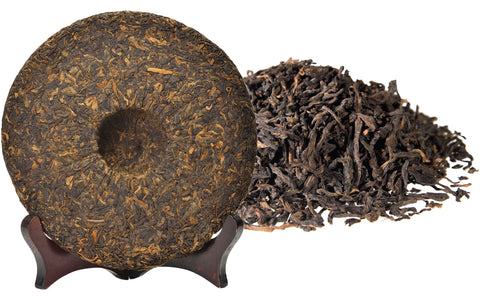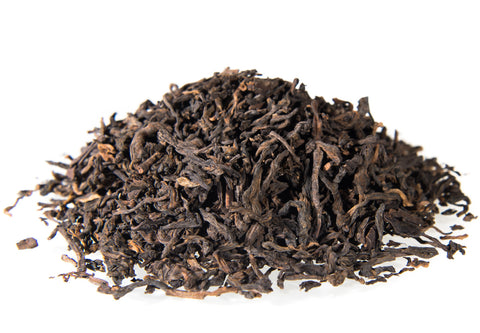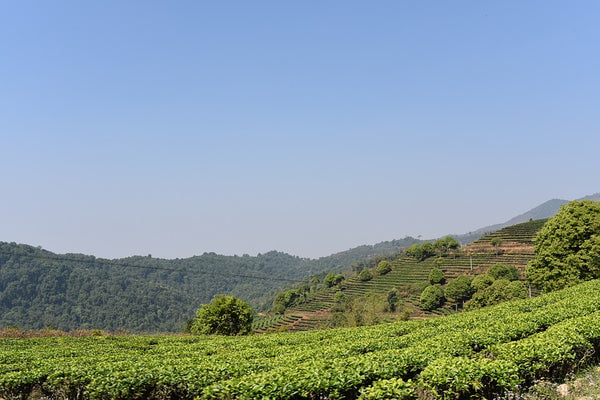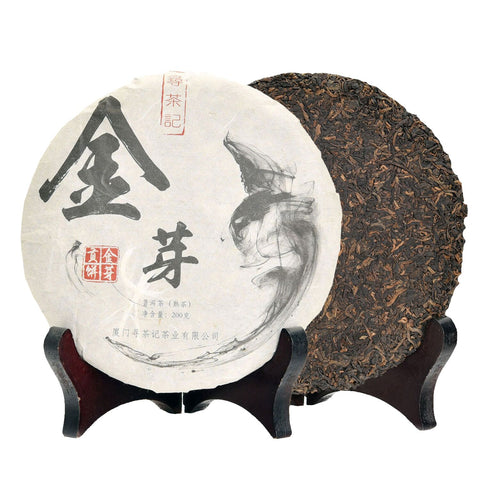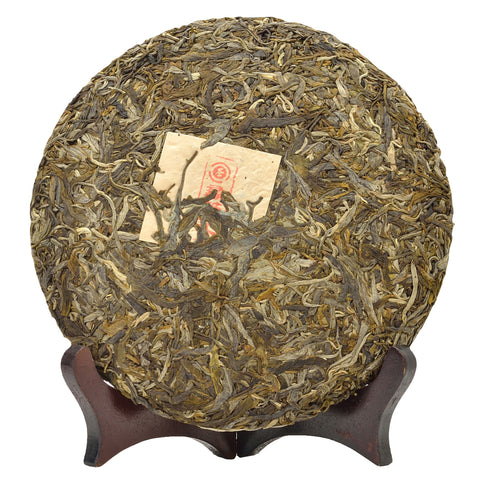Both Hei Cha and Pu-erh are known as fermented teas, so many wonder what the actual difference between the two tea types is.
First, What Is Hei Cha (黑茶)?
Literally meaning "Black Tea" (or, as some say, "Dark Tea"), Hei Cha is not the same black tea we are used to in the West, which is actually called "Red Tea" (Hong Cha) in China.
The origin of Hei Cha dates back many centuries ago. Its production methods are a somewhat iconic part of Chinese tradition passed on for many years. Hei Cha production has a rich heritage and diverse craftsmanship spread across multiple China provinces. Hei Cha is a post-fermented tea category that includes teas like Shou Pu-erh, Liu Bao, and Lu An. Hunan province is a major producer of Hei Cha. Its most well-known Dark Teas include Ya'an Zang Cha, Fu Zhuan, Hei Zhuan, Hua Zhuan, Qing Zhuan, San Jian, and the iconic Qian Liang Cha.
Hei Cha is an ancient tea with a rich tea history. Especially Liu Bao Hei Cha. The processing techniques of Liu Bao served as the basis for modern-day Ripe Pu-erh preparation (which is quite new and wasn't developed until the 1970s).
Read more about Liu Bao Hei Cha here.
What Is Pu-Erh?
Today, Pu-erh tea is produced in Yunnan, China, and has more than 2,000 years of ancient history.
There are two distinctive types of Pu-erh: Sheng Pu-erh (the raw or green type) and Shu Pu-erh (the ripe or black type). Both Shu and Sheng Pu-erh teas are usually made of Camellia sinensis var. Assamica. After Pu-erh tea is processed and pressed, it is aged, often for many years, resulting in its dark color and bold, mellow flavor.
To learn more about Pu-erh, you can read our article on it here.
Pu-erh is grown and produced exclusively in the Yunnan region of China. If grown or produced anywhere else, even by the same technology, it cannot be called Pu-erh.
What Is The Difference Between Hei Cha and Pu-erh?
Many consider Pu-erh a kind of Hei Cha. Sounds simple, right? Well, it's not.
Unlike Pu-erh, Hei Cha can be produced anywhere in the world, as long as the climate is suitable. The "Pu-erh" label is reserved only for tea originating in Yunnan, China - much like Cognac or Champagne in France.
However, there are still many debates about whether or not pu-erh falls into the Hei Cha category in the tea world today. One of the reasons for this is a common misusage of "oxidation" and "fermentation" terms.
Are Shou Pu-erh and Hei cha "fermented", "post-fermented," or "oxidized"?
Both Shou Pu-erh and Hei Cha belong to the post-fermented teas category. That is primarily due to a processing stage called "Wet Piling" (渥堆 – Wo Dui). During this step, the tea leaves are subject to controlled humidity and temperature, which causes a surge in bacterial development. The bacteria is altering the content of the leaves and transforming the tea taste, aroma and mouthfeel. When this fermentation occurs after the Kill Green (杀青 – Sha Qing) step, we're talking about a post-fermented tea.
"Fermentation" indicates a microbial activity conducted by molds, bacteria, and yeasts, altering the tea leaves' original composition. However, the Chinese term "fermentation" usually includes both the enzymatic oxidation and the microbial fermentation of the raw material.
How about Sheng Pu-erh?
Some schools of thought would categorize only Shou Pu-erh as Hei Cha, while others would include very old Sheng into the category, as well. Some would exclude all types of Pu-erh from the Hei Cha category altogether.
Since Sheng (Raw) Pu-erh is not fermented during the production process, it is generally not considered Hei Cha.
However, while aging in a controlled environment, it can undergo slow endo-oxidation (enzymes derived from the tea leaves themselves) and exo-oxidation (microbially catalyzed). It leads to the "ripening" of the tea, creating a rich and mellow taste and aroma prized by collectors.
Are There Other Differences Between Hei Cha and Pu-erh?
One difference between Pu-erh and most Hei Cha is that while Hei Cha gets sweeter and more mellow with age, the taste itself doesn't change drastically after 5, 10, or even 30 years. Many people describe Hei Cha as having a "fresher" taste than Pu-erh. While the flavor of Pu-erh keeps changing drastically with age, gaining more complexity and a variety of flavor notes.
The taste of a quality Shou Pu-erh is sweet, rich, thick, creamy, and very dark. Furthermore, it has strong woody notes with hints of wet leaves. It is warming, grounding, and comforting.
Compared to Shou Pu-erh, Hei Cha is often more uplifting and has lighter qualities. It has a combined warming and cooling energy as well as heat and dampness expelling properties.
Here are some more things to have in mind when comparing the two tea types:
1. Different raw materials
The main varieties used for Dark Tea production are medium and small leaf species. At the same time, the raw material for Pu-erh tea is Yunnan-native large-leaf species.
2. Different fermentation process
The processing of Dark Tea largely relies on the remaining humidity inside the fresh leaf itself. The wet pile temperature comes from the residual temperature after the Sha Qing step. The characteristics of Dark Tea take shape in the initial steps of the processing.
Raw Pu-erh tea does not have the "wet piling" phase; there's only picking, pan-frying, rolling, and sun-drying. The Ripe Pu-erh though undergoes artificially mustered fermentation via piling with added moisture (sprinkled water).
3. Composition
The varietals used for Hei Cha production have specific chemical content that shortens microbial transformation. It means that the leaves' transformation is relatively not so deep. In addition, the chemical components of Dark Tea are less affected by light.
On the other hand, Yunnan's big-leaf species have rich inner content. That accounts for a longer time of inner transformation and microbial interaction. In addition, Pu-erh tea quality is directly affected by photochemical reactions. It is a crucial quality difference between Pu-erh tea and Dark tea.
While plenty of technicalities differentiates these two tea categories, we urge you not to get caught up in the classifications themselves. We suggest trying as many different types of Hei Cha and Pu-erh as possible and deciding on the differences of taste, aroma, and mouthfeel for yourself.
